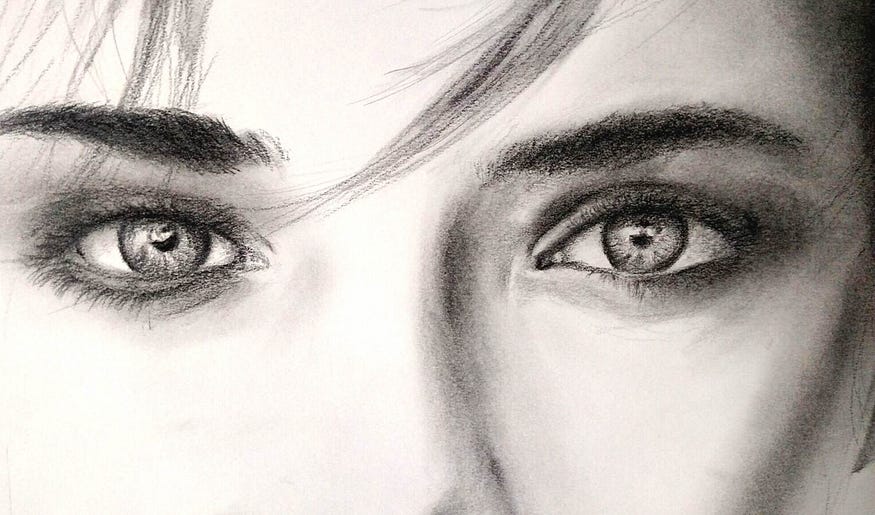There I was at the end of 1975. I was 29 years old. I had an excellent job as a TV repairman, a beautiful wife, and an amazing daughter. I thought life was going well. Within a few months, I would fail an FCC exam, lose my job, and my wife wanted to leave me with my daughter. And the ensuing divorce costs money.
I looked at the situation dispassionately. I had no income and regular expenses. I knew that TV repair was about to go the way of the Dodo. I wanted to do more than making a living. I wanted to be happy and help others to be satisfied. I began to wrestle with the age-old question, “What do I want to be when I grow up?â€.

Still-life with Eyes, Scan by Author/Artist.
What work could I do that I would fall in love with it? I did not want a career but a calling. I wanted something that I could enjoy for the rest of my life. I looked at my friends. Some were happy enough for them but were on the treadmill. Others were not happy enough at all. A small group of friends was encouraging all the time. Not all of them were financially comfortable but happy nonetheless. Then I looked at what each was doing every day. There was an actor, two dancers, a writer, and an artist. They each lived their lives on their terms. I had chosen! I would become an artist of some kind.
That was the easy part. I bought charcoal, paint, brushes, pads of paper, and canvas. I painted and drew everything I could imagine. The efforts came from the heart, but the results were disappointing. However, there were enough of them that I began to call myself an artist. There was a large Arts and Creativity Seminar in Minneapolis in the spring. I would have to attend. The timing was perfect for me.
I drove to Minneapolis and checked in to the hotel. In the elevator, I was alone with a pleasant woman also there for the seminar. She asked me what I did. I proudly told her that I was an Artist. She wondered what kind of art. I told her I paint. She asked, what do you paint? I said that I painted old barns, still life, and flowers. She became animated and said, “You must paint people!â€. I responded, “People are hard.†She said they are just still lifes with eyes. This statement struck a chord with me. The next day, in the elevator, I had an identical conversation with a different woman. I was surprised by the coincidence. On the last day of the seminar, I had the third conversation with the third woman. It was a repeat of the first two. By now, I should give portraiture a try. I learn slowly, but I do understand.
When checking out of the hotel, I discovered those three women at the desk, too. It turned out that they were sisters and each a portraitist in different parts of the country. We laughed when the introductions and subsequent conversation about the elevator rides came up. We all went our separate ways, but I began to take portraiture seriously. I did several charcoal sketches that were terrible. I was not discouraged, however. After I returned home, I had lunch with our city manager. He asked about what I was doing now. I told him, and he said that an art fair would be held in Central Park the following weekend. He insisted that I bring two chairs and my easel to do live sittings in the park.
That is what I did the following weekend. I invited young ladies to sit for 20 minutes while drawing their portraits. I was amazed by their reactions. Of course, they posed for me. That was before they saw my skill level. They were all polite, but I knew the portraits were terrible.
The next day I was back. I put a sign on my easel that offered a charcoal portrait for $5.00. I was busy all day. I had to force time for breaks. At the end of the day, I had $80.00 in my pocket. My work became much better as the day wore on. The last sketches were beginning to look like the subject. The success buoyed me.
The third day began early, with two people waiting for me to set up. My new sign offered the sketch for $10.00. I was as busy as I could be with a queue. I began to notice that there were people behind me watching the process. I heard a few of their comments and was encouraged. I went home with more than $200.00 in my pocket.
The three portraitists told me that the first 100 sketches would be the hardest and that I should not be discouraged. I was more than halfway to that target. I also had the encouragement of the crowd watching me work.
Other exhibitors told me that there were many art fairs to attend throughout the summer. I signed up with as many as I knew and continued to schedule and sign up for every weekend through the summer. I met many other artists and learned about the circuit that many followed. That first summer taught me a lot.
That seminar and the first “Art in the Park†weekend is how it began.
207
2





0